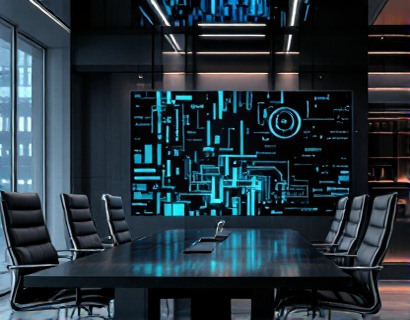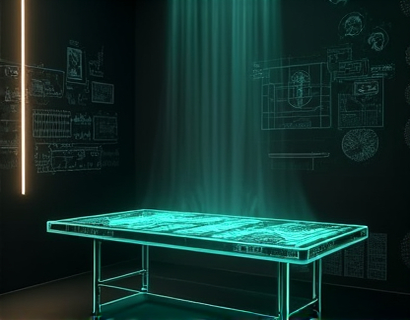Maximizing Architecture Firm Efficiency with Advanced Software Solutions
In the dynamic field of architecture, the integration of advanced software solutions has become pivotal in transforming how firms manage their operations and deliver exceptional user experiences. These technological advancements are not merely tools but transformative forces that optimize internal processes, streamline management, and enhance collaboration among team members. By leveraging these solutions, architecture firms can significantly boost productivity, allowing architects to concentrate on their creative endeavors without being bogged down by administrative tasks.
Streamlined Internal Processes
The core of any successful architecture firm lies in its ability to manage projects efficiently from conception to completion. Advanced software solutions offer comprehensive project management tools that enable firms to track progress, allocate resources, and manage timelines with unprecedented precision. These platforms provide real-time visibility into project statuses, facilitating informed decision-making and proactive issue resolution. By automating routine tasks such as scheduling meetings, sending reminders, and generating reports, these tools free up valuable time for the team to focus on more strategic aspects of project management.
One of the significant benefits of these software solutions is their ability to integrate various aspects of firm operations into a unified system. This integration eliminates the need for disparate tools and manual data entry, reducing errors and increasing efficiency. For instance, a project management software can seamlessly connect with design software, financial management tools, and communication platforms, creating a cohesive workflow that enhances overall productivity.
Enhanced User Experience
The user experience extends beyond the clients to encompass all stakeholders within the firm, including architects, project managers, and support staff. Advanced software solutions are designed with user-centric approaches, ensuring that the tools are intuitive, user-friendly, and tailored to the specific needs of architecture professionals. This focus on usability leads to higher adoption rates and more effective utilization of the software, ultimately benefiting the firm's operations.
For architects, these tools mean a more streamlined design process. Design software integrated with project management features allows for seamless transitions between conceptualization and execution. For example, changes made in the design phase can automatically update related documents and schedules, ensuring consistency and accuracy throughout the project lifecycle. This level of integration not only saves time but also minimizes the risk of errors and miscommunications.
Boosting Collaboration and Communication
Collaboration is a cornerstone of successful architecture projects, and advanced software solutions play a crucial role in fostering effective teamwork. Cloud-based platforms enable real-time collaboration, allowing team members to work on the same project simultaneously, regardless of their physical location. This capability is particularly valuable for firms with remote workers or multiple offices, as it ensures that everyone is on the same page and can contribute to the project in real-time.
Communication tools integrated into these platforms further enhance collaboration. Features such as instant messaging, file sharing, and video conferencing facilitate smooth information exchange and reduce the need for lengthy email threads or disjointed phone calls. This streamlined communication not only speeds up the decision-making process but also fosters a more cohesive team environment.
Improved Resource Management
Effective resource management is essential for the smooth operation of any architecture firm. Advanced software solutions provide robust tools for managing human resources, equipment, and materials. By centralizing resource data, firms can gain insights into availability, utilization rates, and cost implications, enabling more informed allocation decisions.
For instance, a resource management module can track the availability of team members, assign tasks based on skill sets and workloads, and alert managers when resources are over-allocated or underutilized. This level of visibility helps prevent bottlenecks and ensures that projects stay on track. Additionally, the ability to monitor equipment and material usage can lead to better inventory management and cost control.
Financial Management and Reporting
Financial management is a critical aspect of running a successful architecture firm. Advanced software solutions offer comprehensive financial management tools that simplify budgeting, cost tracking, and reporting. These tools enable firms to create detailed budgets for each project, monitor expenses in real-time, and generate accurate financial reports with minimal effort.
One of the key benefits of these financial tools is their ability to provide predictive analytics. By analyzing historical data and current trends, firms can forecast future costs and identify potential financial risks. This proactive approach allows for better financial planning and helps maintain profitability. Moreover, automated reporting features save time and reduce the likelihood of errors, ensuring that stakeholders receive accurate and timely financial information.
Scalability and Flexibility
As architecture firms grow and evolve, their software needs must adapt accordingly. Advanced software solutions are designed to be scalable and flexible, accommodating the changing requirements of firms of all sizes. Whether a firm is a small startup or a large, established practice, these solutions can grow with the business, providing the necessary tools and support at each stage of development.
Scalability also extends to the ability to integrate with other systems and third-party applications. As firms adopt new technologies or partner with other businesses, the software should seamlessly integrate these additions without disrupting existing workflows. This flexibility ensures that firms can continue to innovate and stay competitive in a rapidly changing industry.
Enhancing Client Interactions
Client satisfaction is paramount in the architecture industry, and advanced software solutions can significantly enhance the client experience. By providing clients with access to project dashboards and real-time updates, firms can keep clients informed and engaged throughout the project lifecycle. This transparency builds trust and ensures that clients feel involved in the decision-making process.
Additionally, client management tools within these platforms help firms organize client interactions, track communication, and manage feedback efficiently. This organized approach ensures that client needs are promptly addressed, leading to higher satisfaction rates and repeat business. The ability to centralize client data also facilitates better service personalization, allowing firms to tailor their offerings to meet specific client requirements.
Case Studies and Success Stories
Several architecture firms have already experienced the transformative impact of advanced software solutions. For example, a mid-sized firm in New York leveraged a comprehensive project management platform to streamline their workflow. Within six months, they reported a 30% reduction in project delays and a 25% increase in client satisfaction scores. The real-time visibility and collaboration features of the software enabled their team to respond quickly to changes and maintain clear communication with clients and stakeholders.
Another case in Los Angeles involved a large architecture firm that implemented a financial management tool to better control project costs. The firm saw a 20% reduction in overruns and an improvement in budget adherence. The predictive analytics feature allowed them to identify potential cost issues early, enabling timely interventions and cost-saving measures.
Future Trends and Innovations
The architecture software landscape is continually evolving, with new innovations on the horizon. One emerging trend is the integration of artificial intelligence (AI) and machine learning (ML) into software solutions. AI can automate complex tasks such as design optimization, material selection, and even predictive maintenance of construction materials. ML algorithms can analyze vast amounts of data to identify patterns and provide insights that human analysts might miss, further enhancing decision-making processes.
Another exciting development is the use of virtual and augmented reality (VR/AR) in the design and presentation phases. These technologies allow architects to create immersive experiences for clients, enabling them to visualize and interact with designs in a more realistic manner. This not only enhances the client experience but also aids in early detection of design flaws, reducing the need for costly revisions later in the project.
Conclusion
The integration of advanced software solutions in architecture firms is not just a trend but a necessity for staying competitive and efficient in today's fast-paced industry. These tools streamline internal processes, enhance user experiences, and foster collaboration, ultimately leading to higher productivity and better project outcomes. By embracing these technologies, architecture firms can focus on their core mission of creating innovative and sustainable designs while leaving the complexities of business management to the software.










































